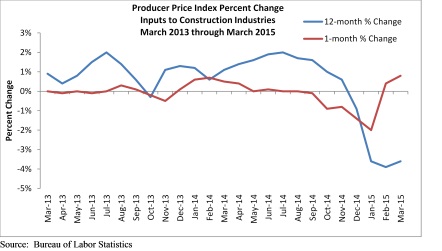Results from the Bureau of Labor Statistics showed that prices for construction materials rose 0.8% in March. According to Associated Builders and Contractors, Inc., it was the largest monthly increase in more than two years.
Prices for construction materials have risen for two straight months after falling for the previous six.
Although prices are up on a monthly basis, statistics showed that input prices are down 3.6% on a year-over-year basis, the fourth consecutive month this has occurred. The steady decline in input prices is the longest streak since 2009 as crude petroleum prices fell 4% in March and are down eight of the last nine months.
"Though U.S. nonresidential and residential segments continue to expand, global construction volumes remain suppressed by widespread weakness in Asia, Europe, and Latin America," said ABC Chief Economist Anirban Basu. "With the U.S. dollar likely to get stronger over the next few months as domestic interest rates begin to rise, there is little likelihood of significant increases in construction input prices over the next six to nine months. Overall producer prices managed to increase 0.5% on a monthly basis, the first increase since June 2014. This reading serves to increase the likelihood that the Federal Reserve will begin to increase short-term interest rates later this year."

There were only two key material categories that saw an increase in construction prices in March: fabricated strucutal metal produce prices (0.4%) and natural gas prices (1.5%).
While these two inputs rose, others fell:
- Prices for plumbing fixtures dropped 0.3% in March but remain up 2.5% year-over-year.
- The price of prepared asphalt, tar roofing, and siding dipped 0.4% in March.
- Iron and steel prices dropped 2.5% in March and are down 11.5% year-over-year.
- Prices for steel mill products slipped 1.9% in March and are down 4.8% on a yearly basis.
- Concrete products prices were flat but up 4.1% year-over-year.
- Crudge petroleum prices dropped 4% in March and are down 55% from the same time last year.
- Crude energy material costs decreased 1.4% in March and are down 43.7% from the previous year.
- Softwood lumed prices fell 4.1% and are down 7.4% year-over-year.
- Prices for nonferrous wire and cable were flat in March and rose 2.5% on a yearly basis.
To read the entire report, click here.
Related Stories
| Oct 12, 2010
Holton Career and Resource Center, Durham, N.C.
27th Annual Reconstruction Awards—Special Recognition. Early in the current decade, violence within the community of Northeast Central Durham, N.C., escalated to the point where school safety officers at Holton Junior High School feared for their own safety. The school eventually closed and the property sat vacant for five years.
| Oct 12, 2010
Guardian Building, Detroit, Mich.
27th Annual Reconstruction Awards—Special Recognition. The relocation and consolidation of hundreds of employees from seven departments of Wayne County, Mich., into the historic Guardian Building in downtown Detroit is a refreshing tale of smart government planning and clever financial management that will benefit taxpayers in the economically distressed region for years to come.
| Oct 12, 2010
Gartner Auditorium, Cleveland Museum of Art
27th Annual Reconstruction Awards—Silver Award. Gartner Auditorium was originally designed by Marcel Breuer and completed, in 1971, as part of his Education Wing at the Cleveland Museum of Art. Despite that lofty provenance, the Gartner was never a perfect music venue.
| Oct 11, 2010
HGA wins 25-Year Award from AIA Minnesota
HGA Architects and Engineers won a 25-Year Award from AIA Minnesota for the Willow Lake Laboratory.
| Sep 30, 2010
Luxury hotels lead industry in green accommodations
Results from the American Hotel & Lodging Association’s 2010 Lodging Survey showed that luxury and upper-upscale hotels are most likely to feature green amenities and earn green certifications. Results were tallied from 8,800 respondents, for a very respectable 18% response rate. Questions focused on 14 green-related categories, including allergy-free rooms, water-saving programs, energy management systems, recycling programs, green certification, and green renovation.
| Sep 21, 2010
Forecast: Existing buildings to earn 50% of green building certifications
A new report from Pike Research forecasts that by 2020, nearly half the green building certifications will be for existing buildings—accounting for 25 billion sf. The study, “Green Building Certification Programs,” analyzed current market and regulatory conditions related to green building certification programs, and found that green building remain robust during the recession and that certifications for existing buildings are an increasing area of focus.
| Sep 16, 2010
Gehry’s Santa Monica Place gets a wave of changes
Omniplan, in association with Jerde Partnership, created an updated design for Santa Monica Place, a shopping mall designed by Frank Gehry in 1980.












